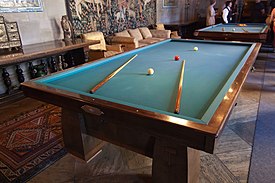 A carom billiard table and billiard balls | |
| Highest governing body | Union Mondiale de Billard (UMB) |
|---|---|
| First played | 18th century France |
| Characteristics | |
| Contact | No |
| Team members | Single opponents, doubles or teams |
| Mixed-sex | Yes, sometimes in separate leagues/divisions |
| Type | Indoor, table, cue sport |
| Equipment | Billiard ball, billiard table, cue stick |
| Venue | Billiard hall or home billiard room |
| Presence | |
| Olympic | No |
| World Games | 2001 – present |

Carom billiards, also called French billiards and sometimes carambole billiards, is the overarching title of a family of cue sports generally played on cloth-covered, pocketless billiard tables. In its simplest form, the object of the game is to score points or "counts" by caroming one's own cue ball off both the opponent's cue ball and the object ball on a single shot. The invention as well as the exact date of origin of carom billiards is somewhat obscure but is thought to be traceable to 18th-century France.[1]
There is a large array of carom billiards disciplines. Some of the more prevalent today and historically are (chronologically by apparent date of development): straight rail, one-cushion, balkline, three-cushion and artistic billiards.[1]
Carom billiards is popular in Europe, particularly France, where it originated. It is also popular in Asian countries, including Japan, the Philippines, South Korea, and Vietnam, but is now considered obscure in North America, having been supplanted by pool in popularity. The Union Mondiale de Billard (UMB) is the highest international governing body of competitive carom billiards.
- ^ a b Shamos, Michael Ian (1993). The Illustrated Encyclopedia of Billiards. New York: Lyons & Burford. pp. 10, 15–17, 26, 41–42, 46, 53, 72<--Probably 79 in 1999 ver.-->, 82, 86–87, 92, 104, 115, 157–158, 196, 229, 232–233, 244–245. ISBN 1-55821-219-1.